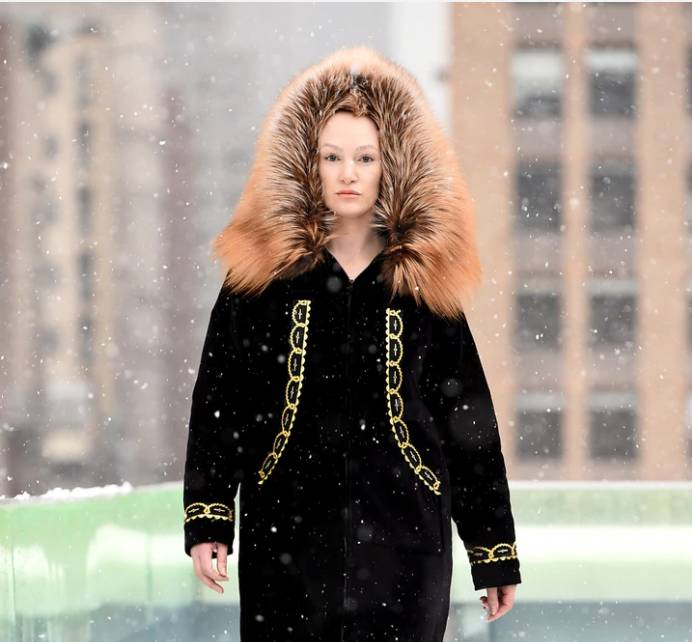
- Details
- By Jenna Kunze
On the February morning of the New York Fashion Week runway show exhibiting a collection of Iñupiaq parkas, designer Bobby Brower (Alaska Native Iñupiaq) awoke in Manhattan to snow.
“All of my models were so happy,” Brower, 36, told Native News Online. “They're like ‘finally! An appropriate thing to wear on the runway.’ It was perfect for my collection.”
Eight professional models donning Brower’s designs are captured in photographs strutting down a rooftop catwalk in Manhattan’s SoHo neighborhood, comfortably adorned in the felted parkas with elaborate fur hoods and trim as the snow dusts down.
Want more Native News? Get the free daily newsletter today.
But the coats aren’t just meant to look warm, Brower said. They’re meant to keep wearers warm in subzero temperatures, down to -50 Fahrenheit.
“It's part of our culture,” Brower said. “Being Alaska Native and growing up in the Arctic, it’s survival gear. It’s not just, ‘I killed these animals so that I could wear fashion.’ It's about keeping my kids warm and keeping my family warm.”
Brower, the designer behind Arctic Luxe, traveled over 4,000 miles last month to make her career dreams come true. After she learned she’d been accepted into New York Fashion Week last April, she began preparing eight atigiit, or parkas, at her home in Anchorage, where she’s recently relocated from her hometown in the Arctic, Utqiaġvik.
One of the male coats was made from sealskin pelts Brower salvaged from a big storm last year, when around 40 dead seals washed up on the beach in Utqiagvik. Brower and her brother were able to skin nine of them, and used the meat to feed animals at the beach.
“It was like I was recycling,” she said.
That coat will now be shown on loan as part of a nine-month long exhibit at The Museum of International Folk Art in Santa Fe, New Mexico.
To make up the cost of travel to New York—plus the $6,000 venue space—Brower hosted fundraising events and had fundraising events for her handmade parkas.
In the end, she said the exposure from New York Fashion Week was well worth it.
“I'm a single mom of four kids. So it was really hard for me to hold on to all my parkas because it took me about a year to prepare everything,” she said. “But I didn't only do this for myself, you know, I feel like I represented Alaska Natives as a whole. I think it was really needed for people, especially our young people.”
Although Brower wasn’t able to bring her own models to the show, her next big event— Indigenous Fashion Week Toronto, Canada this June—will showcase her work on exclusively Indigenous models. She said that the more exposure her contemporary Iñupiaq wares gets, the better it will be for young Natives like her children.
“There's still a lot of racism and hate towards Natives,” she said. “Being able to show that I went to New York Fashion Week and showed Alaska Native culture on the runway is crazy. I don't know what will come out of New York Fashion Week. I can't wait to see what things are going to come next.”
More Stories Like This
Watermark Art Center to Host “Minwaajimowinan — Good Stories” ExhibitionMuseums Alaska Awards More Than $200,000 to 12 Cultural Organizations Statewide
Zuni Youth Enrichment Project Takes Top Emerging Artist Apprentices to Phoenix for Artistic Exploration and Cultural Immersion
From Dishwasher to Award-Winning Chef: Laguna Pueblo's Josh Aragon Serves Up Albuquerque's Best Green Chile Stew
Rob Reiner's Final Work as Producer Appears to Address MMIP Crisis
Help us defend tribal sovereignty.
At Native News Online, our mission is rooted in telling the stories that strengthen sovereignty and uplift Indigenous voices — not just at year’s end, but every single day.
Because of your generosity last year, we were able to keep our reporters on the ground in tribal communities, at national gatherings and in the halls of Congress — covering the issues that matter most to Indian Country: sovereignty, culture, education, health and economic opportunity.
That support sustained us through a tough year in 2025. Now, as we look to the year ahead, we need your help right now to ensure warrior journalism remains strong — reporting that defends tribal sovereignty, amplifies Native truth, and holds power accountable.
 The stakes couldn't be higher. Your support keeps Native voices heard, Native stories told and Native sovereignty defended.
The stakes couldn't be higher. Your support keeps Native voices heard, Native stories told and Native sovereignty defended.
Stand with Warrior Journalism today.
Levi Rickert (Potawatomi), Editor & Publisher

